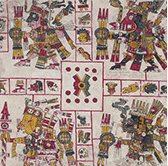Manuscript Department
THE MANUSCRIPT DEPARTMENT AND ITS SECTIONS
The Manuscript Department preserves, studies and makes available the manuscript collections of the Vatican Library. The Manuscript Section is concerned with the collections of literary materials (around 80,000 volumes), while the Archival Section, which was created at the end of the 1970’s, is entrusted with the preservation and the care of the more archival collections (around 75,000 volumes of documents). However, the distinction between the two spheres is not always as clear and simple as it may appear from the handbooks. As a result, there is a good amount of documentary material among the non-archival manuscript collections. The extraordinary richness of the Vatican manuscript collections - Latin, Greek and Oriental - make it one of the world’s outstanding libraries in terms of the quantity and the quality of the manuscripts preserved there, which range from papyrus codices of the Gospels and of other New Testament writings, transcribed only a few decades after they were composed, to late antique manuscripts of Vergil and Terence; from famous palimpsests to precious manuscripts of the High Medieval period; from the masterpieces of Byzantine miniature to those of the Italian Renaissance; from musical and Oriental collections to the libraries and archives of the great families which gave the Church Popes and Cardinals; from scholarly notes and papers to collections of letters and of autographs from the sixteenth to the twentieth centuries. The breadth of the chronological spectrum and the variety of the subject matters, of the materials and of the types of books which are represented here mean that the Vatican Library is indeed, in the words of the Prefect Franz Ehrle (1845-1934), a “library of manuscripts” around which the collections of printed books came to be gathered. Established by the Popes with a truly “catholic” breadth of scope, the Vatican Library and its collections of manuscripts have gathered everything which, over the centuries of human cultural endeavour, has appeared worthy or noble. It is not, then, a purely theological or ecclesiastical library, but rather an asylum and a refuge for all those products of human culture which are beautiful and worthy of preservation. Throughout its history, the Vatican Library has always remained true to this Christian humanism; and the most tangible proof of this is made up of its collections of manuscripts. Two further sections of the Manuscript Department are also part of the Manuscript Section: the Pontifical Addresses Section and the Reading Rooms and Stacks Section.
MANUSCRIPT COLLECTIONSARCHIVAL COLLECTIONS
INVENTORIES, INDICES AND CATALOGUES
The inventories, indices and catalogues which describe the Vatican manuscript collections are a reflection of the diversity and of the centuries-old sedimentation of the collections themselves. They range from hand-written inventories and indices from the seventeenth century and later (some of which came to the Vatican Library together with the collections as they were purchased) to typewritten inventories from the twentieth century; from printed catalogues (starting with the eighteenth-century catalogue of Assemani and continuing with the series begun under Leo XIII [1878-1903] and still progressing today) to the current electronic catalogue. This last catalogue, which has only just been inaugurated and is limited for now to the Latin collections, is being built up by recuperating data from a card index created in the middle of the twentieth century, the so-called “Bishop card catalogue”, from the name of the librarian of the University of Michigan at Ann Arbor, William Warner Bishop (1871-1955), who conceived and promoted it. The printed catalogues provide information that is then electronically converted to accompany the digitized version of the manuscripts, but only the most significant data is used for the task to accompany the digital images. Not all the collections of the Vatican Library are served by satisfactory modern printed catalogues; however, the continuous work of scholars who, over the centuries, have worked with the collections of the Library have produced an impressive mass of analytical descriptions and research on the Library’s manuscripts. A large proportion of these works, which have been published in the most diverse places (periodicals, monographs, catalogues and repertories) and mostly by publishers not affiliated with the Vatican, are listed in the various bibliographies which have appeared in the series “Studi e Testi”.
STAFF
The professional staff which works in the Manuscript Department is made up primarily of Scriptores (a category which dates from the sixteenth century and includes Scriptores Latini, Graeci and Orientales), “Assistants” and “Vice Assistants”. Their main task is to catalogue, to study and thus to make available to scholars the manuscript collections of the Library. It is a long and difficult task, requiring above all an unremitting effort which always falls short of the results which one might wish for but which never gives up in the face of the immensity of what remains to be done. Contrary to a commonly held belief, the Vatican Library does not hold any secret collections which are hidden away for more or less unavowable reasons. Its greatest secret - its astonishing history and that of the slow accumulation of its treasures - is in fact accessible to anyone who has the patience, the tenacity and the skills which are needed to study them.
CONTACT DETAILS
- DIRECTOR Dr. Claudia Montuschi: contact by email
- OFFICE: contact by email





